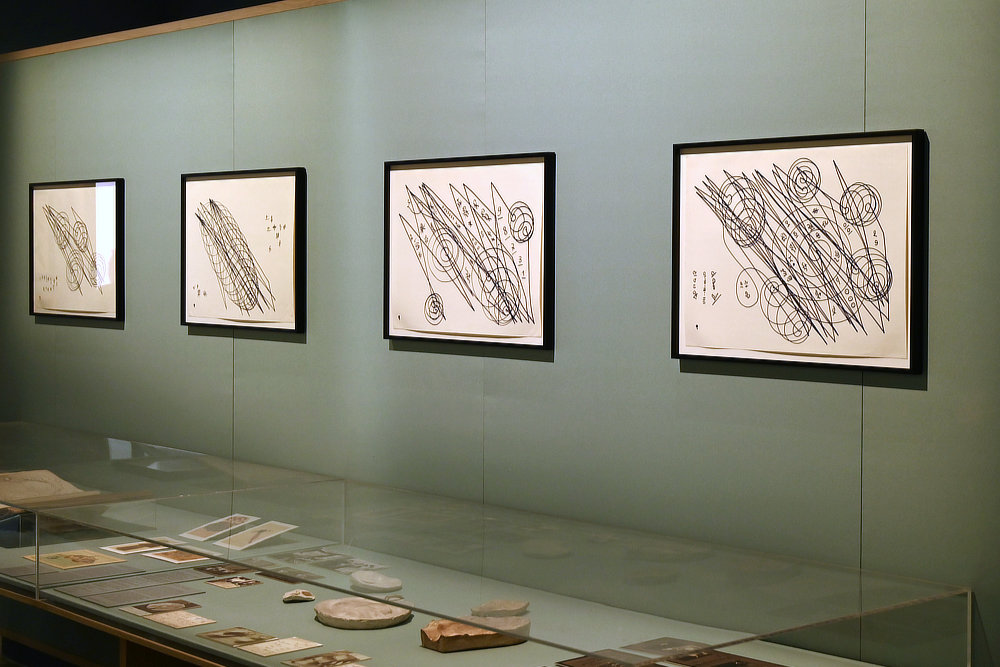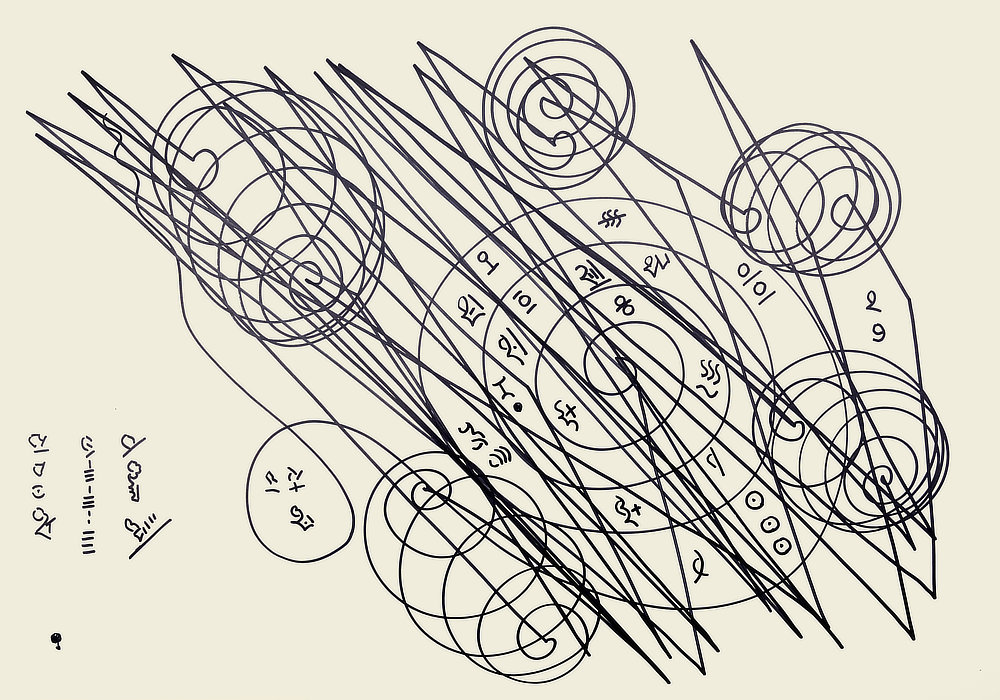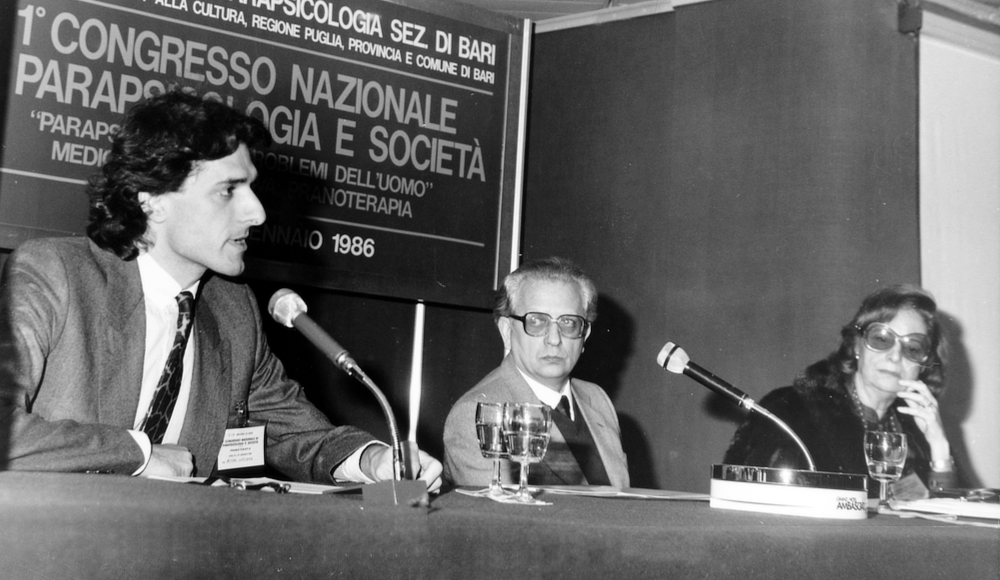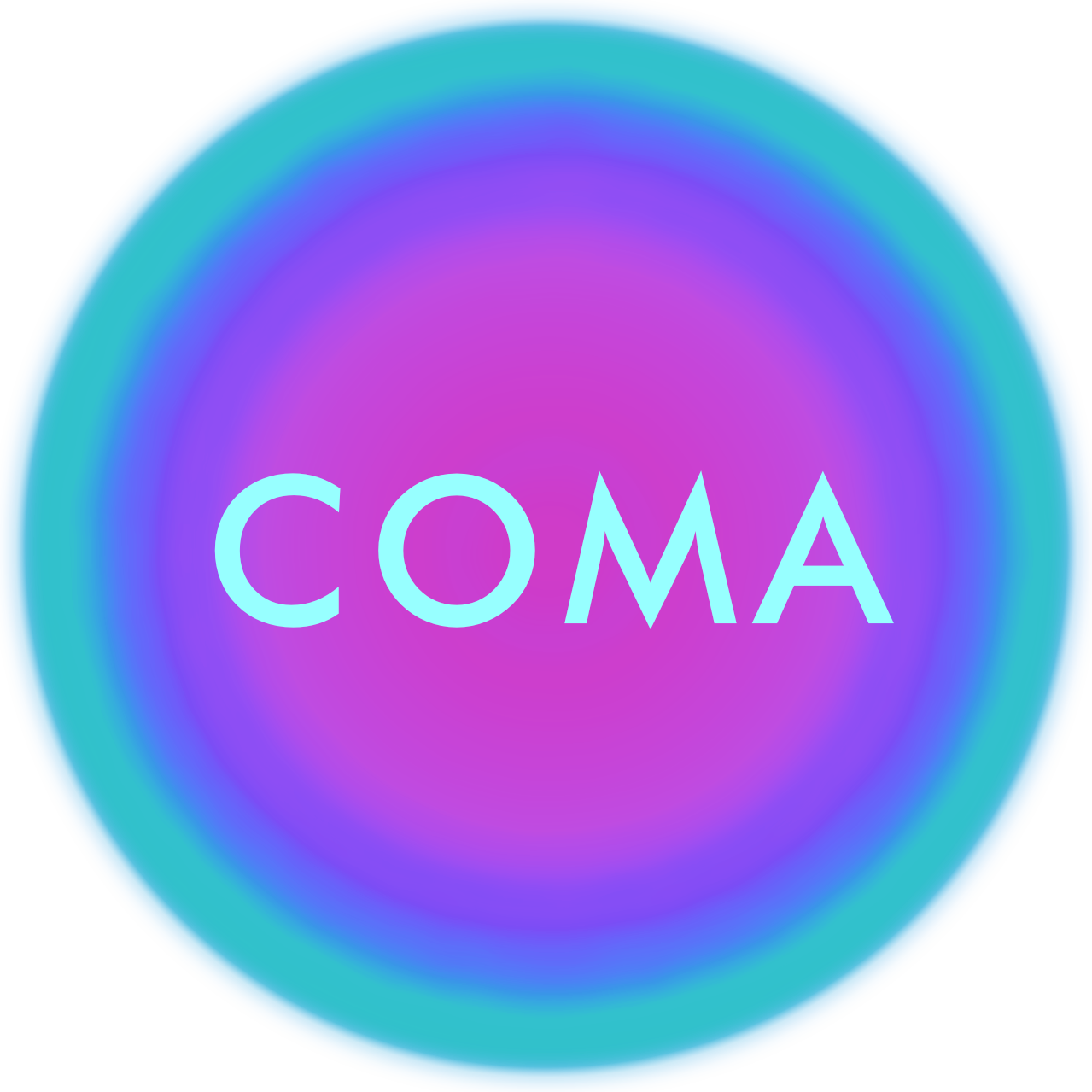MILLY CANAVERO: SURVEYING THE SUBLIME SPACE
In one of the so-called time capsules in the main exhibition in the Central Pavilion of the 59th Venice Art Biennale "The Milk of Dreams", curator Cecilia Alemani has placed works by mediumistic artists in dialogue with works of visual and concrete poetry. The space is dominated by the four impressive drawings by Milly Canavero from my collection, filled with schematic graphic forms – an impressive posthumous recognition of the singular work of the medium from Genoa. [1]
 Four works by Milly Canavero et the 59th Venice Biennale © 2022 Elmar R. Gruber
Four works by Milly Canavero et the 59th Venice Biennale © 2022 Elmar R. Gruber
Milly Canavero's career as a mediumistic draftswoman began on a gloomy November day in 1976 in her large stately home in Genoa when she heard the order from a disembodied entity to make a drawing. She had pen and paper at hand, because she had already been practicing automatic writing for three years. In a few moments, her hand stroked the page in sweeping, calm movements. As she set the pen aside, she saw a neatly drawn network of straight and curved lines, all connected. A stylized flower had been drawn in the lower left corner of the page. Dumbfounded and stunned, she stared at the drawing, which she executed in a single unstruck motion. Since then, almost every evening, always at the same time, she produced these strange automatic drawings – for decades.
Milly Canavero was born Amelia Antonia Serra in Genoa, Italy, on January 17, 1910. As a child, she received a strict education. The hardships and deprivations in interpersonal interactions she experienced as a child continued in her marriage to the surgeon, Prof. Michelangelo Canavero. Milly Canavero had no profession, the marriage remained childless, and in the house her sister-in-law ran a strict regime. In this oppressive environment she became increasingly lonely and withdrew more and more from interpersonal contacts with her husband and closest relatives. The only thing that gave her comfort was music.
She said about herself: "My mediumistic life began with suffering." [2] In the early 1970s, while on vacation in Montecatini, she happened to meet a medium who took her along to a spiritualistic séance. Milly Canavero had not had any contact with paranormal or spiritualistic phenomena until then. This world was completely foreign to her and she did not know what to make of it. However, her curiosity was piqued. When she came back to Montecatini the following year and once again attended a spiritualistic séance, she was completely fascinated by the other reality that revealed itself to her. Back in Genoa, she began to explore the world of the paranormal. She experimented with the so-called automatic spelling with the help of a planchette. While her husband always went to bed early to be rested for his work the next morning, Milly picked up the planchette. Right away, her hand automatically produced meaningful texts.
Shortly thereafter, her husband died suddenly and unexpectedly. Milly Canavero had enjoyed only a modest education and had attended a business school. She was all the more amazed at the increasingly sophisticated content of what her hand was composing, now writing automatically without the aid of a planchette, apparently without her own conscious input. The writings were signed by deceased friends and foreigners and finally by individuals who revealed themselves as extraterrestrial entities. Higher and higher entities made themselves known, finally Athos and Helios, as the highest.
These messages mostly have a religious content, whereby the Christian world of reference remains central throughout. It sometimes seems quite strange when an inhabitant of a foreign galaxy proclaims the religious ideas and the idea of God of Christianity, specifies them and enriches them with esoteric and mystical ideas. Helios, for example, proclaims the universe as an outer manifestation of inner space. He speaks of God as the creator of innumerable earths and each seems to know the Christian doctrine in the same way. Everything exists in immensity, Athos instructs her, "everything, the great Father, the great Son, the great Love Holy Spirit, and in this immeasurable Whole lies the Great Power, lies the invisible God, who in time will become visible." [3]
The texts of the entities, especially the very highest among them, reveal loving attention towards their medium. One is tempted to measure with psychological standards and to understand the beings' intimate relationship with Milly Canavero, their kindness and goodness, indeed their affection, as compensation for a life full of hardships. And certainly, they were. But it is precisely this comfort and succor and support from "on high" that allowed Milly Canavero to experience happiness and confidence in her mediumistic work. She felt that she was finally doing something meaningful in her life that gave her satisfaction and strength, and that is why the mediumistic séances become for her the most important commitment of the rest of her life.
 Milly Canavero, drawing of February 7, 1985 © 2022 Elmar R. Gruber
Milly Canavero, drawing of February 7, 1985 © 2022 Elmar R. Gruber
A few years later, under the influence of higher beings, Milly Canavero began to make characteristic geometric drawings. Until the end of her life she would create countless such works. On many of them, unknown characters can be found between the lines or even outside the graphic motif. After a drawing, Milly Canavero had to turn the sheet over and write a kind of commentary in an aphoristic sentence on the back. The text on the back was also signed with a flower.
Milly was surprised to find that additional messages of “the Flower" conveyed with the drawings also amounted to many scientific, especially cosmological topics, such as the beginnings of life, black holes and the death of stars. She was even more surprised and incredulous when an entity that called himself Michelangelo Buonarotti made himself known. [4] From this entity, over many years, she received a kind of gradual teaching on philosophical and spiritual issues. From 1985 to 1990 her otherworldly interlocutor was Johann Wolfgang von Goethe, who transmitted poems to her and gave messages about nature, colors and painting. [5]
While drawing or writing automatically, Milly was never in a trance. When she sat down at the table in the evening, where sheets of paper and pens were ready, it was enough for her to concentrate and immediately a state of absorption or "flow", as Csikszentmihalyi described this experience of being completely absorbed in an activity, set in. [6] All she needed was this state of concentration. She said, "These drawings always amaze me, because I was used to writing, and when I started drawing, I didn't even understand what I was drawing on the paper. But the phenomenon continued, and I noticed that I was changing the way I expressed myself. At first, I also felt psychosomatic factors, trembling in my hand and arm, burning in my larynx and nose, but not anymore. I have learned to make myself available at certain times, and I stand ready." [7]
Milly never had any interest in drawing, nor any aptitude for it. She would much rather have composed. In the first drawings, wavy lines appeared most often, along with simple stylized flowers on long, supple stems. Eventually geometric shapes filled the sheets: intersecting triangles, lines, arrows pointing one direction, spirals. Technically interesting is the fact that Milly Canavero made all her geometrically precise works freehand, without a ruler, compass, stencil or other tools.
From the automatic messages she continued to write down, some explanations emerged as to the meaning of the symbols, which appeared in countless repetitions, variations and patterns of order, and which always seem to unite opposites: Demarcation and dissolution of boundaries, unambiguity and ambiguity, centrifugal kinetic dynamics and centripetal gathering and stillness. Above all, they are pictorial illustrations of the way in which multiplicity emerges from the One and how one can rise again from multiplicity to the One, the Universal Spirit, by following the Light. For Milly Canavero, the rays in the drawings represented the wisdom emanating from the Universal Spirit. They are the means by which Spirit manifests itself, permeating the cosmos in its infinity.
The drawings, she said, are renditions of the spiritual maturation process that occurs through cycles of reincarnation. "The Flower" repeatedly pointed out that in each of his incarnations man must be aware of his position in the universe and that each life must be lived in such a way that it serves spiritual ascent and not descent. The Flower spoke of "the conscious emancipation of the mission carried out on Earth." [8]
The contents of the messages of the different supernatural actors in their totality result in a comprehensive and exciting individual mythology, [9] with a series of peculiar and very special formations, which manifests itself most clearly in the drawings of Milly Canavero, but also in individual teachings, such as those of the "Nouri". They represent the idea of energy carriers in the macrocosm and in the microcosm, which are transmitters of spiritual energy as well as vital energy. The Flower had explained the existence of this very special kind of energy in the universe, which expands and which she termed the "nouritic energy." [10] "Nouri", she said, are wandering souls that come together in groups and separate according to the respective degree of evolution of the individual soul and supply energy and spirituality to the living beings. The Nouri, which have grown together into a single essence, are vibrating souls that radiate spirit and energy in the cosmos. The energy of the Nouri manifests rapidly through chained groups emanating from a higher intelligence. Myriads of Nouri permeate the cosmos. They are at the foundation of the vital evolution of man. They are sources of energy for all forms of life.
 Elmar R. Gruber (left) at a parapsychological convention in Bari, Italy, in 1986, with Milly Canavero (right) and Giorgio di Simone | © 2022 Elmar R. Gruber
Elmar R. Gruber (left) at a parapsychological convention in Bari, Italy, in 1986, with Milly Canavero (right) and Giorgio di Simone | © 2022 Elmar R. Gruber
Upon closer inspection the solemn concepts of which Milly Canavero's messages and poems are built like mannerist cathedrals, are only giving the appearance of philosophically profound ideas, whereas they often are a mere collection of empty words. As is so often the case in mediumistic art, such written statements stand in stark disproportion to the impressive graphic work, which expresses an originality that is immediately touching. They also contrast with the personality of Milly Canavero. When I met her for the first time around 1980, she was still in the early stages of her mediumistic development. I experienced a reserved, controlled and courteous lady, who did not have any eccentric traits, nor was she inspired by any desire for recognition. This never changed over the years, during which a friendship grew and we met again and again, usually at conventions, and exchanged ideas about the mediumistically informed artistic process. The rigor and clarity of her drawings are variations on a theme in a very reduced formal language, drawn without hesitation, without corrections, in a manner that I might call “inimitable varied uniformity”. Already André Breton spoke in his seminal essay "Le message automatique" of the "captivating stereotypy", which was characteristic of automatic artistic productions. [11]
For Milly, it was important to leave the drawings together in their entirety, if possible. For her, they reflected and illustrated in a profound way the teachings she had received from different beings and only in their totality would the teachings be understood in their entirety. Very seldom only did she pass on individual works to friends. In this way she gifted me with the four drawings that are part of my collection. The intention was good from the basic idea, so that the works were not scattered all over the world. But in the end, as with many other collections of mediumistic works, it became a real tragedy. The fate of the thousands of drawings that Milly Canavero must have left behind is unknown.
All the better that with this exhibition at the Venice Biennale, at the heart of the mainstream art world, as it were, Milly Canavero is receiving such prestigious posthumous recognition. The notion would certainly have pleased her, especially as her work simultaneously becomes a catalyst for art historical discourse in which creative mediumistic modes of expression are renegotiated.
[1] Elmar R. Gruber, "Sondare l'immenso. I disegni medianici di Milly Canavero alla Biennale di Venezia", Luce e Ombra, 122, 2022, 214-223.
[2] Maria Vittoria Bellisai, I messaggi del fiore: Messaggi e disegni medianici ricevuti da Milly Canavero. Rome, 1981, p. 22.
[3] Bellisai, I messaggi del fiore, p. 25.
[4] Milly Canavero, L'aldilà nelle tradizioni e nella messagistica. Bologna, 2004, pp. 23-27.
[5] Milly Canavero, L'aldilà, pp. 29-45.
[6] Mihaly Csikszentmihalyi, Flow: The Psychology of Optimal Experience. New York, 1990.
[7] Cited in Paola Giovetti, "Messaggi e disegni medianici di Milly Canavero Serra". Luce e Ombra, 122, 2022, pp. 332-338.
[8] Bellisai, I messaggi del fiore, pp. 63-64.
[9] Harald Szeemann, Individuelle Mythologien. Berlin, 1985.
[10] Bellisai, I messaggi del fiore, p. 92.
[11] André Breton, “Le Message automatique”, Minotaure, n° 3, 1933, p. 55-65.
text © 2022 Elmar R. Gruber
